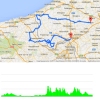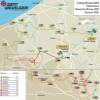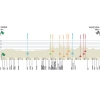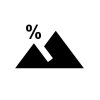Despite the name, riders haven’t started in Ghent for over a decade. The start is in Deinze, some 20 kilometres away. Like Ghent, Deinze is located on the River Leie.
The pack heads west on straight roads. With endless fields left and right, they pass villages like Tielt, Lichtervelde and Kortemark. At Veurne the road heads south and then bends westwards to France. After Herzeele and Wormhout the first hill looms, the Kasselberg. The cobbled climb takes them to the town of Kassel at the top. After a small detour the next climb takes the riders to Kassel once again, this time on a narrow asphalt road.
After Kassel the road continues east. Close to France is the next obstacle, Katsberg – a 500 metres climb at 9%. Atop lies an abbey, still inhabited by monks who are making cheese and Trappist beer.
Hills come and go now in rapid succession. First the Baneberg, a 300 metres climb at 10% with a 20% steepest part, and then the Kemmelberg, the most notorious hill in Gent-Wevelgem. Leaving the village Kemmel the road goes up for 3 kilometres at an average grade of 4%, but with 22% sections to spice it all up. To make it even spicier the road is paved with medieval cobblestones. So when it rains the Kemmelberg can be treacherous, especially just under de top in the forest. To avoid accidents the western descent on cobbles is skipped since 2008 in favour of a small detour on asphalt. Once safely down the Monteberg lays waiting – a 1 kilometre climb at 7%.
Now the riders have some time to take a breather. After an interval in Wallonia they head back for a second climb up the Baneberg, Kemmelberg and Monteberg. At last the climbing is done and the race heads for Ypres to enter the ‘old city’ – actually completely renovated after the destruction during World War I – via the Rijsselpoort. The riders pass the ‘13the century’ Cloth Hall and leave the town via the Menenpoort. Every night the Last Post is played here by buglers in remembrance of the British soldiers who died in Ypres during in the Great War.
After Ypres it’s only long straight roads to the finish line, except for an interlude in Menen that brings some twisting and turning. Thus escapees are always in sight, making the chase an easy one and so Gent-Wevelgem is almost always decided in a bunch sprint. Peter Sagan was the last one who opted for a different scenario. In 2013 he broke free from a front group and soloed to victory. But last year saw a ‘traditional’ sprint again with John Degenkolb besting Arnaud Démare and Peter Sagan.
By the way, Sagan was on the podium in last three editions.
Click here to read race results and race report.
Gent-Wevelgem 2015: Route maps, height profiles, and more
Click on the images to zoom
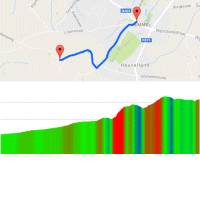 Route and profile Kemmel-Kemmelberg
Route and profile Kemmel-Kemmelberg
 Instagram #kemmelberg
Instagram #kemmelberg
 Kemmelberg at strava.com
Kemmelberg at strava.com
 Streetview Kemmelberg
Streetview Kemmelberg
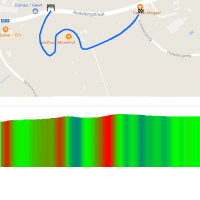 Route and profile Baneberg
Route and profile Baneberg
 Instagram #kemmelberg
Instagram #kemmelberg
 Baneberg at strava.com
Baneberg at strava.com
 Streetview Baneberg
Streetview Baneberg
